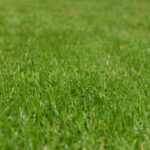Minshad Ansari, Founder and CEO of Bionema Ltd, a biopesticide product testing and technology development company, reports on how to manage turf pests using chemical free solutions.
At the the start of the year I visited golf course that was about to close due to turf damage caused by pests living under the soil. The pests – and the damage – had spread across the grass area, eating and destroying every blade of grass in their wake. This scenario is a nightmare for professionals working in
turf and amenities, but it can be avoided if groundscare teams understand the causes and the steps that can be taken to overcome the problem.
What causes damage to turf?
The most common pests causing this type of damage are chafer grubs and leatherjackets. Chafer grubs
are the soil-dwelling larvae of chafer beetles and leatherjackets are the larvae of the crane fly (daddy long legs). Both types of larvae feed on the roots of grass plants, killing the grasses and leaving large areas of turf stripped of green. Crows, badgers and other wildlife can also add to the problem by digging up the soil to eat the larvae, further stripping the turf.

Until recently, turf and amenity managers were able to control these insect pests with chemical pesticides – it was even common to spray undamaged turf with these products to prevent any infestations. However, due to their toxicity, those chemical pesticides are no longer available, and the chafer grubs and leatherjackets are
enjoying a chemical-free playground that is allowing them to flourish in soils. They are now destroying golf courses, sport fields, racecourses and the general landscape, causing millions of pounds of damage annually.

How can it be stopped?
Biopesticides are filling the gap in the market left by banned chemical pesticides. Biopesticide technology developers – such as Bionema – harness nature by identifying and developing products that use natural enemies to manage insect pests in different sectors. Probably the best known example of a ‘biopesticide’ is the ladybird – gardeners who encourage ladybirds to flourish are less likely to be bothered by aphids.
Unfortunately, ladybirds won’t attack chafer grubs or leatherjackets, but other ‘friendly’ organisms will. Certain species of beneficial nematodes (roundworms) will actively search for insect larvae in the soil. They enter the larvae through natural openings and release bacteria that are lethal to the larvae, killing them within two to three days.
The nematodes breed within the dead larvae, feeding on the body tissues. They reproduce within two weeks and emerge in search of more larvae, and so the natural cycle continues. This self-sustainability offers extended pest control and helps to ensure that overall costs compare favourably with those of old chemical pesticides.
Is it really that easy?
If applied correctly, biopesticides can be at least as effective as old chemical pesticides.
After following our programme for chafer grub control at the Grove Hotel and Golf Course in Hertfordshire, UK, the site’s estate manager Phil Chiverton said: “We saw a more than 80% reduction in chafer grubs in the first year, and further improvements in year two, while at the same time doing less harm to the environment and saving money compared with chemical applications.”
However, biopesticides received some ‘bad press’ when they first became available because they were
not been used correctly. For example, nematodes are susceptible to ultra-violet light and desiccation, so biopesticides containing nematodes should only be applied early in the morning or late in the evening, when there is less direct sunlight. They also function best when surface temperatures are at least 12oC and, while they the soil, watering-logging can reduce their performance. Ensuring conditions such as these for maximising
nematode performance can easily be built into an application regimen once you are aware of them. At Bionema, we see our NemaTrident® biopesticide
as having three parts – the first part is the beneficial nematodes; the second is NemaSpreader®, a biocompatible wetting agent that helps the nematodes to spread and thrive; and the third is the specialist training and advice for our customers on how to optimise the effectiveness of the nematodes. Using all three parts
of the programme – nematodes, wetting agent and our expert advice – there’s no reason why you shouldn’t get great results too.
Is prevention better than cure?
It can take up to three years for turf to recover
from extensive damage from chafer grubs and leatherjackets, so we would certainly recommend that turf and amenity managers should consider applying biopesticides as a preventative measure, rather than waiting for damage to occur. As with the old chemical pesticides, as well as managing active infestations, the nematodes can be applied to ‘healthy’ turf to prevent unforeseen future problems.
Where can I learn more?
In 2019, the devastation caused by chafer grubs
and leatherjackets was so compelling that Bionema organised an Emergency Summit, which was attended by more than 150 people across the UK. Futher summits are planned to pool all necessary expertise. If you are interested in attending one of these events or for furhter information follow Bionema on Twitter @Bionema.
About Bionema
Bionema is a leading biopesticide product testing and technology development company, specialising in chemical- free, organic crop protection. Bionema supplies specialist bio-control products to the horticulture, turf and amenity and forestry sectors, providing training aimed at increasing the product efficacy.For more details email m.a.ansari@bionema.com

